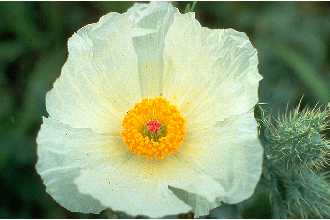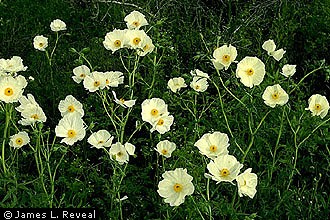 |
|
Clarence A. Rechenthin. Courtesy of USDA NRCS Texas State Office. |
 |
| James L. Reveal @ USDA-NRCS PLANTS Database |
Translate this page:
Summary
Physical Characteristics

 Argemone albiflora is a ANNUAL growing to 1.5 m (5ft) by 0.5 m (1ft 8in).
Argemone albiflora is a ANNUAL growing to 1.5 m (5ft) by 0.5 m (1ft 8in).
See above for USDA hardiness. It is hardy to UK zone 7. It is in flower from May to August, and the seeds ripen from July to September. The species is hermaphrodite (has both male and female organs). The plant is self-fertile.
Suitable for: light (sandy) soils, prefers well-drained soil and can grow in nutritionally poor soil. Suitable pH: mildly acid, neutral and basic (mildly alkaline) soils. It cannot grow in the shade. It prefers dry or moist soil and can tolerate drought.
UK Hardiness Map
US Hardiness Map
Synonyms
A. alba.
Plant Habitats
Cultivated Beds;
Edible Uses
References More on Edible Uses
Medicinal Uses
Plants For A Future can not take any responsibility for any adverse effects from the use of plants. Always seek advice from a professional before using a plant medicinally.
Demulcent Emetic Purgative Skin
A tea made from the leaves is demulcent, emetic and purgative[222]. Caution is advised, the seed oil can cause glaucoma and oedema[222]. An infusion of the plant is used in the treatment of jaundice, skin ailments, colds, colic and wounds[222].
References More on Medicinal Uses
The Bookshop: Edible Plant Books
Our Latest books on Perennial Plants For Food Forests and Permaculture Gardens in paperback or digital formats.

Edible Tropical Plants
Food Forest Plants for Hotter Conditions: 250+ Plants For Tropical Food Forests & Permaculture Gardens.
More

Edible Temperate Plants
Plants for Your Food Forest: 500 Plants for Temperate Food Forests & Permaculture Gardens.
More

More Books
PFAF have eight books available in paperback and digital formats. Browse the shop for more information.
Shop Now
Other Uses
References More on Other Uses
Cultivation details
Easily grown in ordinary light soil in a sunny position[200]. Does best in a poor well-drained soil, often self-sowing on stony and sandy sites[200]. Plants resent root disturbance and are best sown in situ[134].
References Carbon Farming Information and Carbon Sequestration Information
Temperature Converter
Type a value in the Celsius field to convert the value to Fahrenheit:
Fahrenheit:
The PFAF Bookshop
Plants For A Future have a number of books available in paperback and digital form. Book titles include Edible Plants, Edible Perennials, Edible Trees,Edible Shrubs, Woodland Gardening, and Temperate Food Forest Plants. Our new book is Food Forest Plants For Hotter Conditions (Tropical and Sub-Tropical).
Shop Now
Plant Propagation
Seed - sow April in situ[200]. The seed usually germinates in 3 - 4 weeks at 15°c[134].
Other Names
If available other names are mentioned here
Native Range
NORTHERN AMERICA: United States (Connecticut, Massachusetts (southeast), Michigan (southeast), New York (southeast), Illinois, Missouri (southeast), Alabama, Florida, Georgia (south), Louisiana, Mississippi (south), North Carolina (east), South Carolina (east), Texas).
Weed Potential
Right plant wrong place. We are currently updating this section.
Please note that a plant may be invasive in one area but may not in your area so it's worth checking.
Conservation Status
IUCN Red List of Threatened Plants Status :

Growth: S = slow M = medium F = fast. Soil: L = light (sandy) M = medium H = heavy (clay). pH: A = acid N = neutral B = basic (alkaline). Shade: F = full shade S = semi-shade N = no shade. Moisture: D = dry M = Moist We = wet Wa = water.
Now available:
Food Forest Plants for Mediterranean Conditions
350+ Perennial Plants For Mediterranean and Drier Food Forests and Permaculture Gardens.
[Paperback and eBook]
This is the third in Plants For A Future's series of plant guides for food forests tailored to
specific climate zones. Following volumes on temperate and tropical ecosystems, this book focuses
on species suited to Mediterranean conditions—regions with hot, dry summers and cool, wet winters,
often facing the added challenge of climate change.
Read More
Expert comment
Author
Hornem.
Botanical References
200270
Links / References
For a list of references used on this page please go here
Readers comment
© 2010, Plants For A Future. Plants For A Future is a charitable company limited by guarantee, registered in England and Wales. Charity No. 1057719, Company No. 3204567.